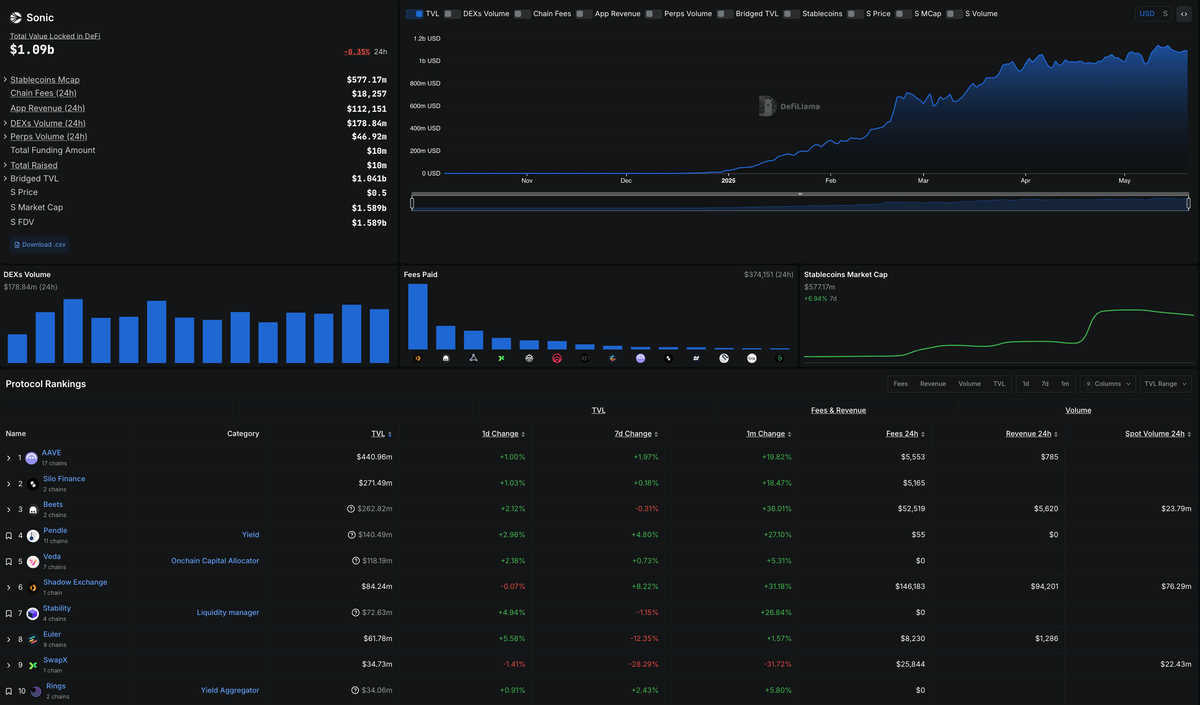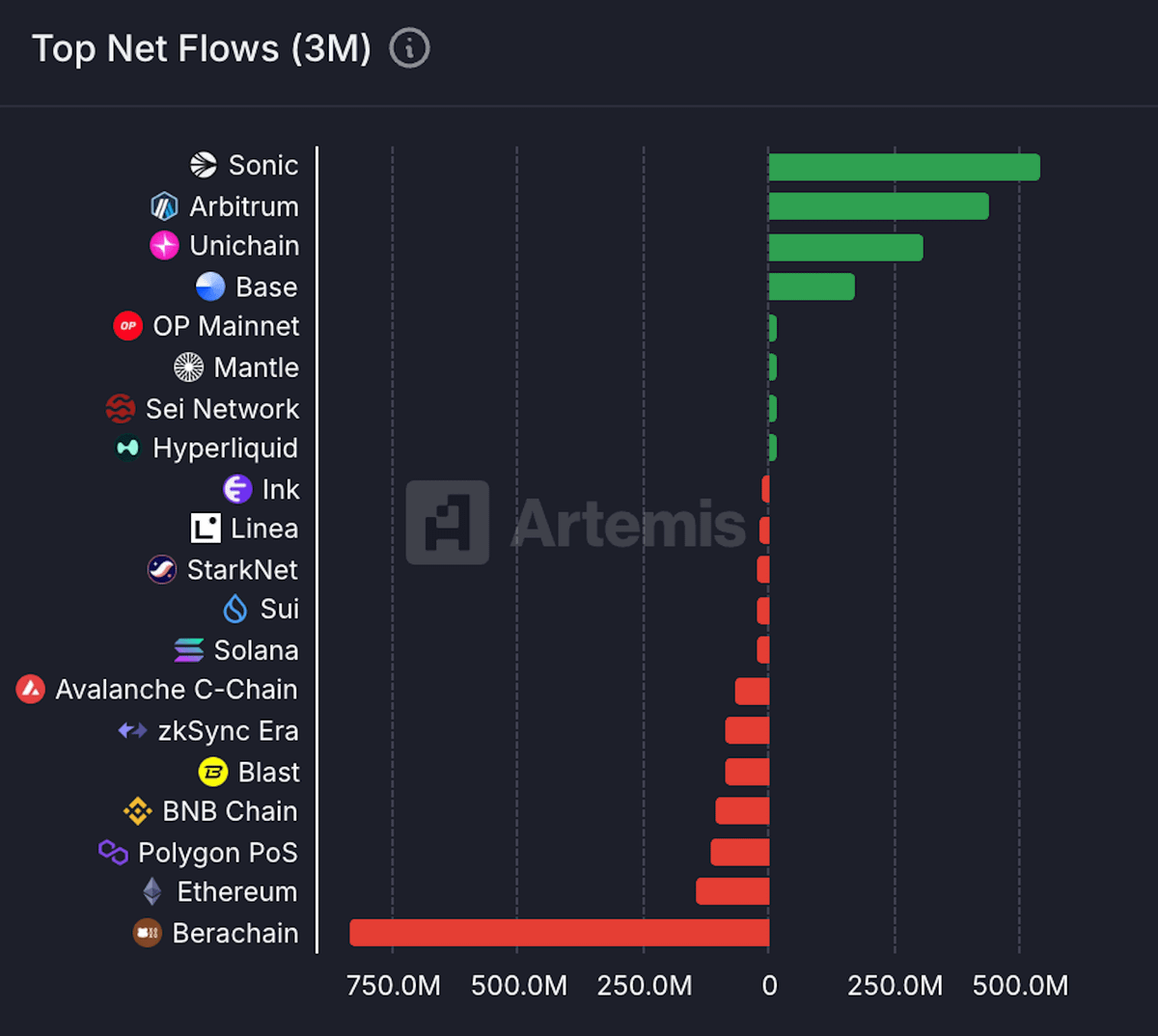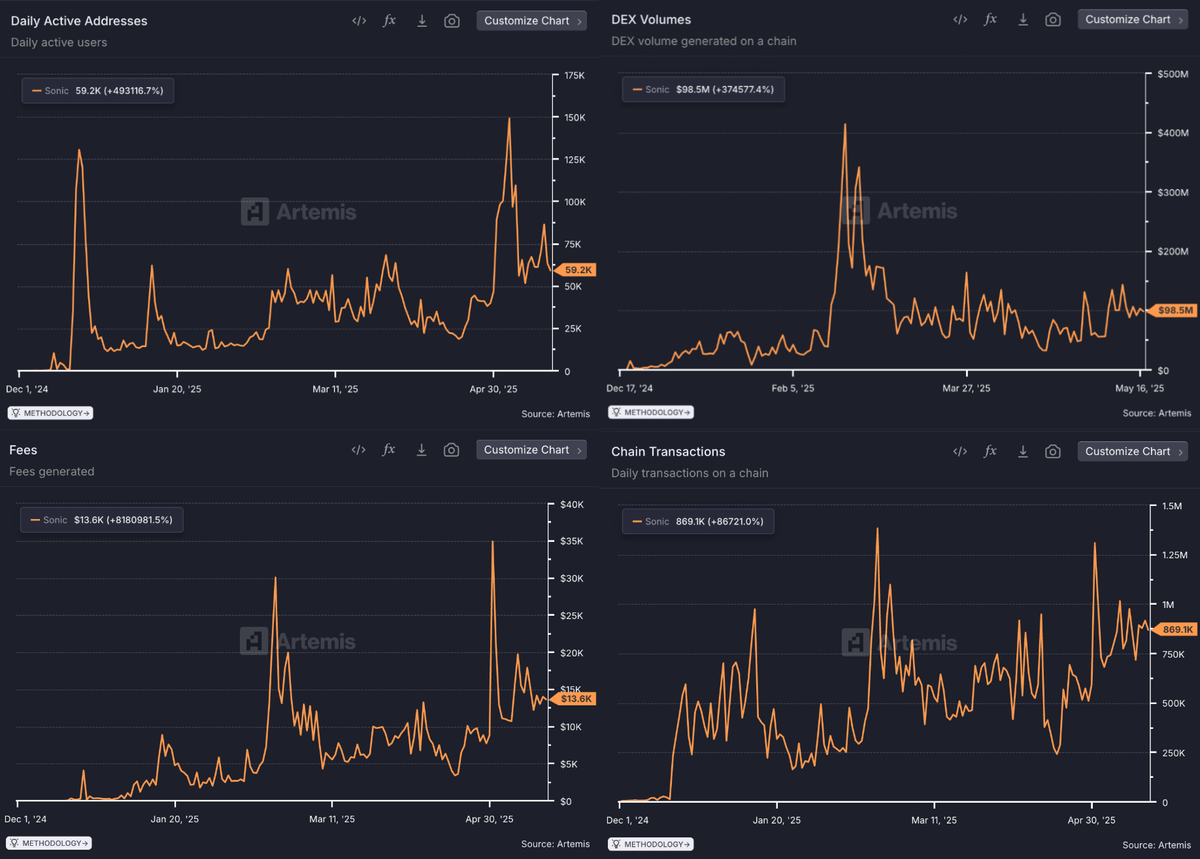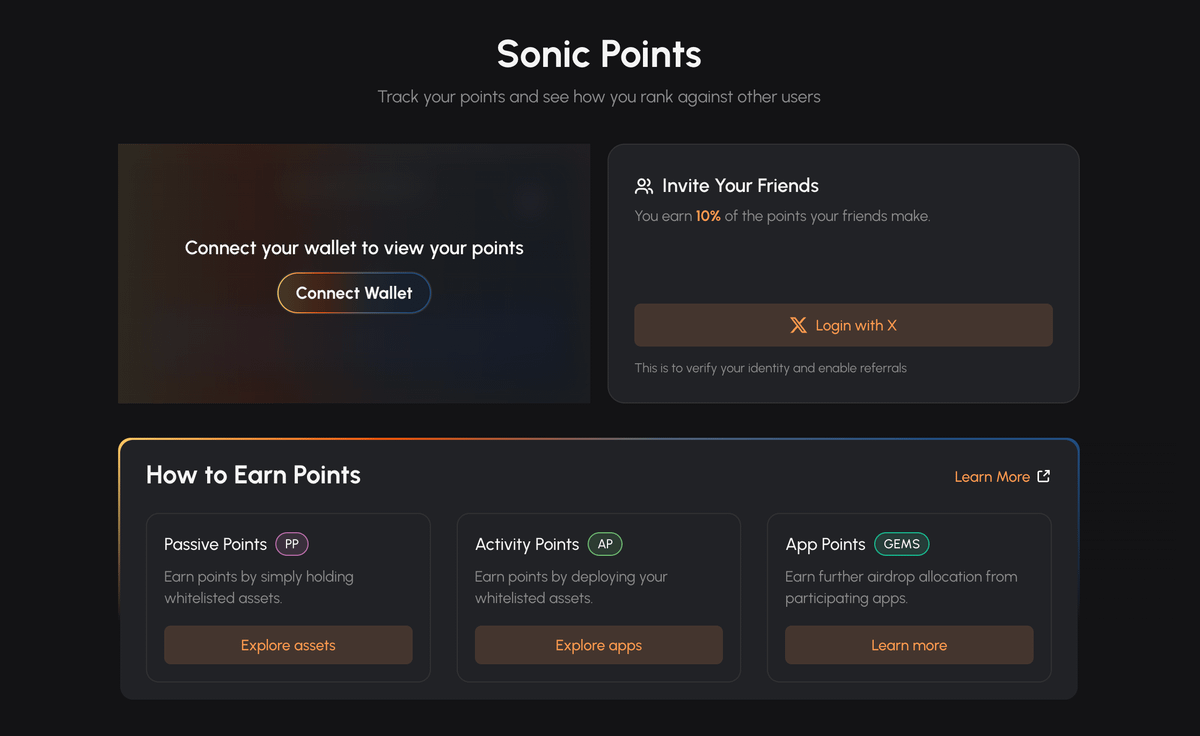Sonic on ollut yksi menestyneimmistä pääverkon julkaisuista / GTM-yrityksistä tähän mennessä tällä syklillä.
Vain kuukausia pääverkon julkaisun jälkeen Sonic on ylittänyt 1 miljardin dollarin TVL:n, ja se on verkko, jolla on suurimmat nettovirtaukset vuoden alusta.
→ Tehokas EVM, rinnakkaissuoritus tulossa
→ 320 ms:n lopullisuus ja teoreettinen raja 370k TPS
→ Natiivisti integroitu luottopisteytysjärjestelmä
→ Kaasun kaupallistaminen (jopa 90 % menee rakentajille)
→ Sonic Boom- ja Airdrop-ohjelman kannustimet
→ Erittäin turvallinen yhdyskäytävä Ethereumiin
→ lisää
@RedactedRes:n myötä kävimme äskettäin uudelleen @SonicLabs-ekosysteemissä selvittääksemme, mitä ketjussa tapahtuu ja miksi.
Katso syväsukellus alta! ↓
𝙎𝙩𝙖𝙩𝙚 𝙤𝙛 𝙩𝙝𝙚 𝙎𝙤𝙣𝙞𝙘 𝙉𝙚𝙩𝙬𝙤𝙧𝙠
@SonicLabs has been live on mainnet for five months,
superseding Fantom, and is aiming for the DeFi throne.
As Sonic just crossed $1B TVL, the trajectory seems promising.
But is @AndreCronjeTech's new chain living up to the hype?
Time to find out ↓
To set the stage, let's break down Sonic's tech stack on a high level first.
We won't go to deep into the weeds though, for a more detailed breakdown of the network architecture and features, check the quoted post below.
➀ 𝗦𝗼𝗻𝗶𝗰 𝗧𝗲𝗰𝗵 𝗦𝘁𝗮𝗰𝗸:
→ Finality of approximately 700ms, outperforming high-performance chains like Aptos (900ms) and significantly ahead of most EVM chains.
→ Achieved throughput of >10,000 TPS, scalable toward 20,000+ with ongoing development to enhance performance through parallel execution.
→ Implements DAG-based asynchronous Byzantine Fault Tolerance (aBFT) consensus (Lachesis) combined with SonicDB, optimizing node storage requirements (~90% reduction compared to Fantom Opera).
→ Uses live pruning to reduce validator storage needs, allowing continuous operation by automatically removing historical data through separate current and archive databases.
→ Minimal transaction fees (typically <1 cent) provide an excellent user experience.
However, while that makes for a strong basis, performance alone is not what drives growth of the onchain economy that Sonic aims to scale.
What really differentiates Sonic from other (EVM) chains, is a bunch of truly unique features, aiming to attract both builders and users effectively.
➁ 𝗖𝗼𝗿𝗲 𝗗𝗶𝗳𝗳𝗲𝗿𝗲𝗻𝘁𝗶𝗮𝘁𝗼𝗿𝘀:
→ Gas Fee Monetization: Developers earn up to 90% of the gas fees generated by their dApps, directly incentivizing high-quality development.
→ Native On-Chain Credit Scoring: Privacy-preserving, on-chain credit scoring without KYC unlocks under-collateralized lending markets estimated at $11.3 trillion.
→ Native Account Abstraction: Seamless onboarding and user interactions via social logins and third-party gas sponsorship.
→ Robust Bridge Security: Sonic Gateway employs decentralized validation and includes built-in emergency withdrawal mechanisms, significantly mitigating traditional bridging risks.
Okay cool, but what about the data?
Are people even using Sonic?
Let's have a closer look at the key ecosystem metrics.
➂ 𝗗𝗮𝘁𝗮-𝗱𝗿𝗶𝘃𝗲𝗻 𝗔𝗻𝗮𝗹𝘆𝘀𝗶𝘀
→ Sonic’s TVL rapidly expanded from ~$27M at launch to around $1.09B within five months, demonstrating sustained capital inflow.
→ Sonic Network secured the highest net inflows (~$505M in the last 3 months, mainly from Ethereum) of all chains, surpassing major competitors such as @arbitrum, @base or @unichain.
→ Dominant DeFi protocols by TVL include @aave V3 ($440.96M), @SiloFinance ($271.49M), and @beets_fi (~$262.82M). This spread of TVL across diverse applications reduces systemic risk and indicates healthy protocol diversification.
→ Daily Active Addresses have surged to a peak of ~170,000, stabilizing around ~60,000 users, indicating robust user retention for now (even tho this metric can easily be manipulated).
→ Daily transaction volumes consistently exceed 800,000, peaking above 1.3 million, indicative of substantial ongoing engagement beyond initial launch hype. We have to once again keep in mind though that these kinds of metrics are rather easy to manipulate.
→ DEX volumes spiked initially to ~$450M daily, with sustained volumes around ~$100M, evidencing strong and stable trading activity + liquidity. However, the organic volume is likely lower.
→ Generated fees have seen peaks around $35,000 daily, stabilizing around $13,600, highlighting significant economic activity and developer revenue potential.
→ Stablecoin market cap ($577.17M) is growing rapidly and bolsters the network's substantial liquidity depth, supporting trading & lending activities.
Overall, the data clearly shows strong fundamentals, indicating that Sonic's strategy to return to Fantom's old DeFi glory is working well.
However, this begs the question: What exactly are all these users doing with their money on @SonicLabs?
➃ 𝗬𝗶𝗲𝗹𝗱 + 𝗣𝗼𝗶𝗻𝘁 𝗙𝗮𝗿𝗺𝗶𝗻𝗴 𝗼𝗻 𝗦𝗼𝗻𝗶𝗰
Undoubtedly, a strong pull factor that attracts liquidity and users from other chains and ecosystems, is the yields to be farmed across liquidity and lending pools in the Sonic ecosystem.
Various venues offer stablecoin markets that yield attractive APYs of 5-12%, while liquidity pools across the ecosystem provide consistent APRs between 15-30%, with some bearing even higher yields, ensuring sustainable incentives for liquidity providers.
Advanced financial products like @pendle_fi (yield tokenization), @eggsonsonic (leveraged yield farming), and @Rings_Protocol (yield-bearing stablecoins) further provide more sophisticated farming strategy options, and broaden the overall scope of opportunities for users.
Last but not least, staking yields remain comparably attractive at 5-8%, augmented by liquid staking derivatives like $stS, that facilitate further DeFi integration, a major improvement compared to Fantom Opera's staking infra that largely lacked any liquid staking options.
However, it's likely not the APYs alone attracting users and fueling a daily transaction count that consistently exceeds 1 million, and a total of unique addresses that is approaching 2.5 million.
While developer activity is significantly boosted by the Sonic Innovator Fund (200M $S tokens allocated) and Sonic Boom developer incentives, Sonic also employs a strategic points-based incentive system designed to drive user adoption and engagement across the ecosystem.
The Sonic Points system operates by rewarding users for performing various on-chain actions such as trading, lending, providing liquidity, staking, and bridging assets onto the network. Each action grants a user a certain number of points, which accumulate to determine eligibility for targeted airdrops of $S tokens.
To further incentivize specific behaviours aligned with ecosystem growth, Sonic introduced multipliers for certain activities, such as depositing stablecoins into key lending markets or providing liquidity to core trading pairs, granting up to 12-15x point multipliers. This substantially amplifies the perceived value of participating in these critical actions, creating a strong incentive for users to actively and consistently engage with DeFi apps on Sonic.
Consequently, users are motivated not only by immediate yields but also by the substantial potential upside associated with future airdrops. This gamified reward structure has notably contributed to sustained user retention post-launch (at least so far), which is reflected in the ecosystem’s high daily active addresses and stable transaction volumes as well.
Sonic’s points-based airdrop system seems to have effectively catalyzed organic adoption and community growth, ensuring users remain active beyond short-term farming incentives by app layer protocols.
➄ 𝗖𝗼𝗻𝗰𝗹𝘂𝘀𝗶𝗼𝗻
Sonic's initial metrics demonstrate decent traction, supported by strong technical capabilities and strategically designed incentives. However, a significant part of its rapid growth appears closely tied to the aggressive reward structures currently in place.
Moving forward, the primary challenge lies in transitioning this incentivized adoption into sustainable organic activity and innovative dApps. While Sonic’s innovations are commendable, the network's true long-term viability and resilience will depend heavily on user retention and ecosystem activity after incentive programs diminish.
It will be particularly interesting to observe whether Sonic can maintain its early momentum and convert transient interest into lasting, fundamental engagement. Sonic's unique DeFi primitives and integrated features such as onchain credit scoring, gas fee monetization and native account abstraction could be crucial here.
⚠️ This is not financial advice and the report is NOT sponsored by any third-party.




42,25 t.
14
Tällä sivulla näytettävä sisältö on kolmansien osapuolten tarjoamaa. Ellei toisin mainita, OKX ei ole lainatun artikkelin / lainattujen artikkelien kirjoittaja, eikä OKX väitä olevansa materiaalin tekijänoikeuksien haltija. Sisältö on tarkoitettu vain tiedoksi, eikä se edusta OKX:n näkemyksiä. Sitä ei ole tarkoitettu minkäänlaiseksi suositukseksi, eikä sitä tule pitää sijoitusneuvontana tai kehotuksena ostaa tai myydä digitaalisia varoja. Siltä osin kuin yhteenvetojen tai muiden tietojen tuottamiseen käytetään generatiivista tekoälyä, tällainen tekoälyn tuottama sisältö voi olla epätarkkaa tai epäjohdonmukaista. Lue aiheesta lisätietoa linkitetystä artikkelista. OKX ei ole vastuussa kolmansien osapuolten sivustojen sisällöstä. Digitaalisten varojen, kuten vakaakolikoiden ja NFT:iden, omistukseen liittyy suuri riski, ja niiden arvo voi vaihdella merkittävästi. Sinun tulee huolellisesti harkita, sopiiko digitaalisten varojen treidaus tai omistus sinulle taloudellisessa tilanteessasi.


